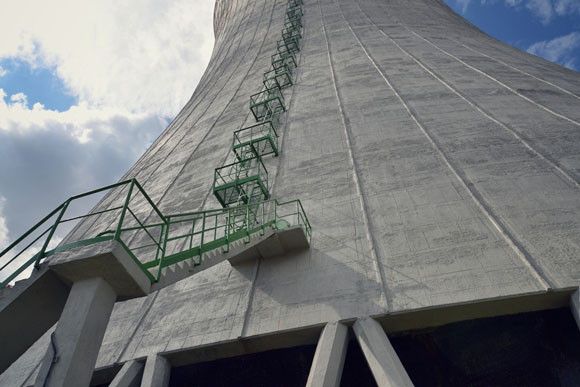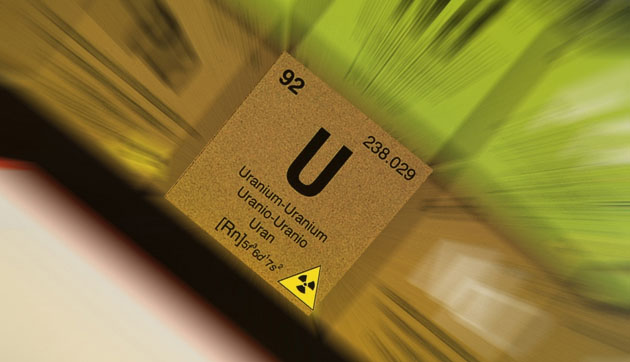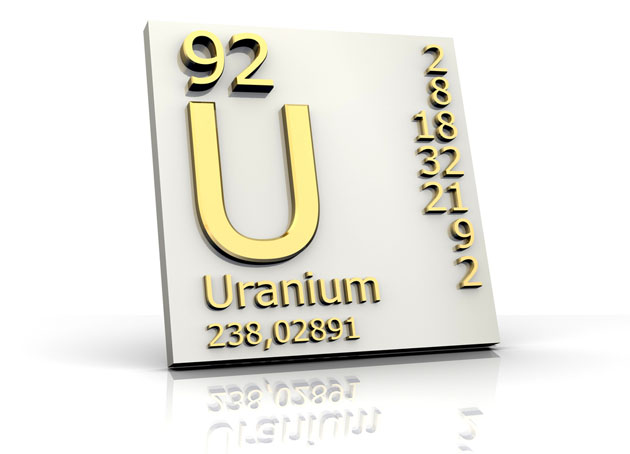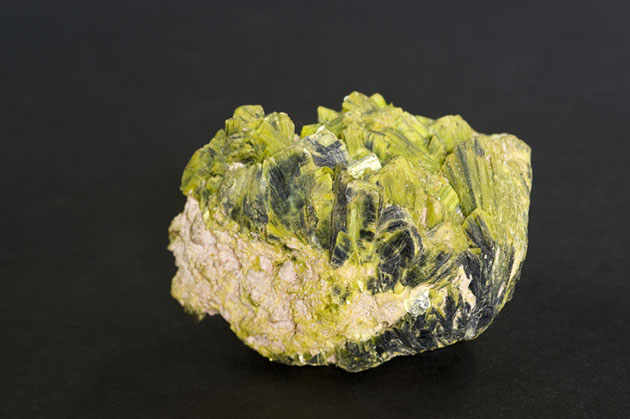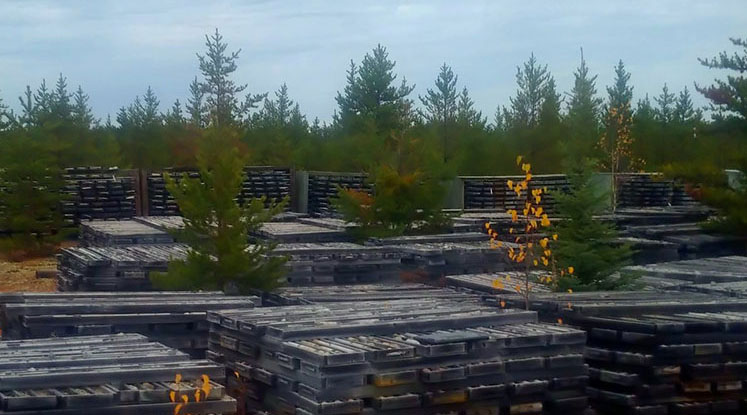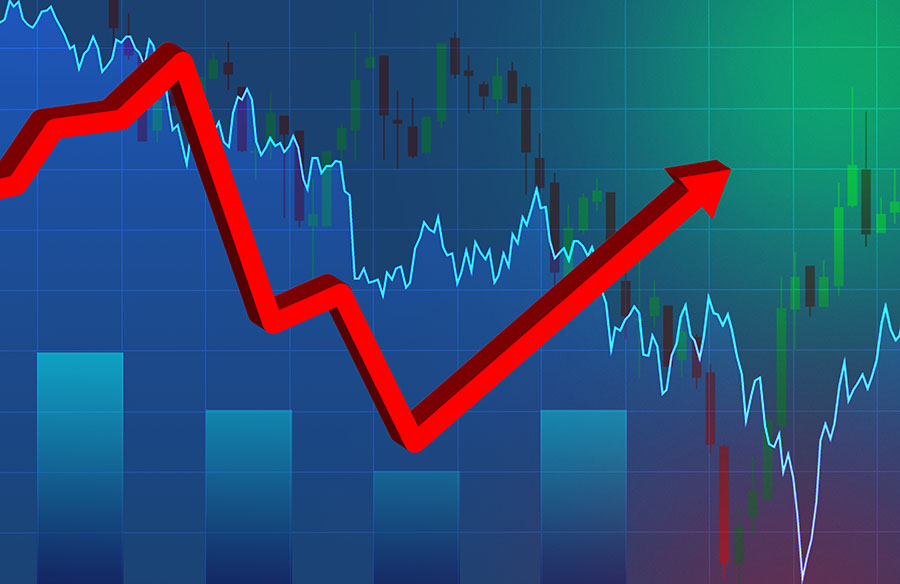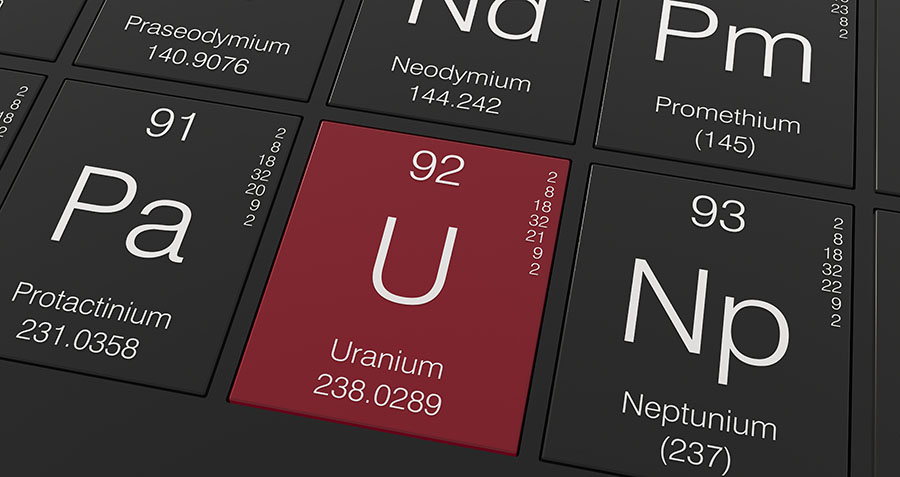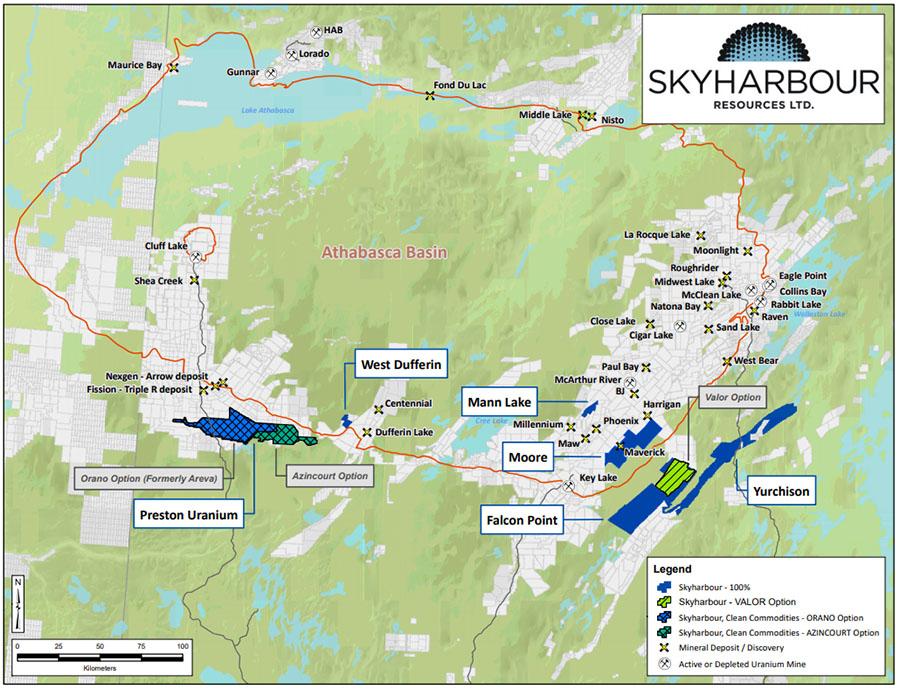TICKERS: BNNLF, CCO; CCJ, CPT; CPL, CSO, DML; DNN, EFR; UUUU, EXT, , KAH, PDN, RIO; RTPPF, RSC, URG; URE, , UEC, UUU, XRG, TUE
Geordie Mark: Coal and Uranium Generate Heat
Interview
Source: Brian Sylvester of The Energy Report (11/15/11)
 From fossil fuels to fission, growing global demand for power generation offers investment opportunities. Thermal coal is heating up and the uranium junior mining sector is set for development and a wave of consolidation. Geordie Mark, mining analyst with Haywood Securities in Vancouver, shares his thoughts in this exclusive Energy Report interview.
From fossil fuels to fission, growing global demand for power generation offers investment opportunities. Thermal coal is heating up and the uranium junior mining sector is set for development and a wave of consolidation. Geordie Mark, mining analyst with Haywood Securities in Vancouver, shares his thoughts in this exclusive Energy Report interview.
The Energy Report: There have been recent takeovers in the coal sector, including the $1 billion (B) takeover of Grande Cache Coal by a Chinese and Japanese business combination. What should investors take away from that deal?
Geordie Mark: Investors need to be aware that metallurgical coal is intimately related to the steel market. Our expectations for growth in the steel market drive our expectations for growth in metallurgical coal. It is a positive sign that the market sees the value of such a strategic commodity. We've seen a lot of activity this year in the space, highlighted by the $4B takeover of Riversdale by Rio Tinto (RIO:NYSE; RIO, ASX) primarily for Riversdale's metallurgical coal asset base in Mozambique.
TER: Chinese imports of metallurgical coal have grown along with China's steel sector. Do you see this trend slowing in the near term?
GM: With steel demand increasing, we expect China to have an ever-increasing footprint in terms of metallurgical coal consumption. Long-term, there is still big potential for metallurgical coal, although we may see a plateau in pricing in the near term. China is also the largest producer of metallurgical coal, producing more than 500 million tons (Mt) in 2010, but we are expecting continued importation of the commodity in China, as well as Japan, India and South Korea.
TER: Which juniors with advanced coal projects are likely to see some interest from potential suitors on the heels of the Grande Cache deal?
GM: The first that comes to mind is Xinergy Ltd. (XRG:TSX), a company that produces thermal coal, but which recently acquired two metallurgical coal projects. One already produces high-voltage metallurgical coal and Xinergy aims to bring the other into production next year.
Another name is Corsa Coal Corp. (CSO:TSX), which is in production at its own metallurgical coal projects, both surface and underground, in the U.S.
TER: What about Coalspur Mines Ltd. (CPT:TSX; CPL:ASX)?
GM: To put Coalspur in context, it helps to talk about thermal coal. The company's Vista Coal Project is a strategic asset as there is still underlying, increasing demand for seaborne thermal coal, especially in Asia.
TER: This is coal that is used primarily in power plants, is that right?
GM: Yes, its predominant use is to provide base-load for electricity generation. Coal remains the largest form of base-load power in the U.S. Almost 80% of power in China comes from thermal coal; Japan and India are also very big thermal coal consumers, and importers.
We see Coalspur being able to introduce itself into the thermal coal space through its Vista Project in Alberta, Canada. Coalspur just tied up a contract through the Ridley Terminals in Prince Rupert for up to 8.5 million tons per annum in export volume starting in 2015. Furthermore, the company also signed a memorandum of understanding with CN Rail to co-ordinate coal transport to Prince Rupert starting 2015. The project is right next to the railroad, so it is ideally positioned to add high-quality thermal coal into the seaborne market over the next few years. The large scale of this project, with such high-quality product, and advanced stage of negotiation for infrastructure support, is unparalleled in Canada. We expect Coalspur to make big inroads over the next few years. We have a 12-month target of $2.80 on Coalspur, and it is trading around $1.80.
TER: There is a lot of negative news about the pollution that coal-burning power plants produce. Are you saying that, despite the headlines, the thermal coal market isn't going away any time soon?
GM: That is definitely what the projections tell us. The International Energy Agency predicts increases in thermal energy consumption over the next 20–25 years. I don't see thermal coal—the largest form of base-load power across most economies—going away anytime soon as most of tomorrow's growth is expected to emanate from the Advancing Economies.
TER: Do you have confidence in Coalspur's management?
GM: Absolutely. The management team has built and run mines in the coal space in various jurisdictions. I am very comfortable with what they will be able to achieve.
TER: The last 12 months have not been kind to uranium companies, especially juniors. Year-over-year, the share price for Denison Mines Corp. (DML:TSX; DNN:NYSE.A), a mid-tier uranium producer, fell 36.5%; Uranium One Inc. (UUU:TSX) dropped 46.2%, and Paladin Energy Ltd. (PDN:TSX; PDN:ASX), a uranium project developer, lost 63.7%. Over the same time period, the TSX Composite Index slipped a mere 4.4%. How do you pitch uranium equities to retail and institutional investors at this point?
GM: The equities have taken a very big hit over the last year, despite the uranium spot price being around where it was a year ago. This equity market artifact is more related to sentiment, I think.
We still see uranium very much as a strategic commodity, even following the nuclear accident in Fukushima. This view is supported by the acquisition and offer activity in the sector in 2011. The sector's growth outlook looks solid, driven by expected demand increases in China, Russia, South Korea and petroleum-producing nations such as the United Arab Emirates and Saudi Arabia.
TER: The Australian Bureau of Agriculture and Resource Economy estimates that roughly 107 thousand tons (Kt) uranium will be needed to meet demand in 2016. That is about 20 Kt more than the 86 Kt yellowcake expected to be consumed this year. Is an extra 20 Kt a year enough to drive up the share prices of uranium juniors?
GM: I think we need some other catalysts. We need to remove the negativity sentiment toward this sector. For example, we need to see new reactors being built. We need to see a timeframe for non-operating reactors, say those in Japan, to be put back online. Investors need to see more usage of existing reactors and new growth coming into play.
We're starting to see new demand. A couple of new reactor proposals got the go-ahead in China recently, with construction for the reactors expected to start next year. Progress is starting to be made, albeit on an incremental basis.
The strategic nature of uranium is highlighted by recent interest shown by Cameco Corp. (CCO:TSX; CCJ:NYSE), the world's largest uranium-only producer, and Rio Tinto in Hathor Exploration Ltd.'s (HAT:TSX.V) Roughrider asset. Rio Tinto's involvement in the space is very interesting because that company deals with a range of commodities, and it allocates capital across geography and across sectors. By taking an interest in North American assets, Rio Tinto is increasing its stance in uranium.
TER: As I understand it, Cameco came in with what Hathor considered a low-ball bid. Then Rio countered. Has Cameco countered yet?
GM: Cameco has upped the ante and offered an increased bid of $4.50 per share. Cameco has more operational synergy in the region than Rio Tinto, given Cameco's infrastructure and expertise in the Athabasca Basin. Ultimately, Cameco could provide a greater offer for Hathor than Rio and still maintain similar future margins on the operation.
TER: Does the bidding war for Hathor tell us that the major uranium producers place a premium on jurisdiction?
GM: Yes, but we also have to be cognizant of the inherent quality of the asset. For Rio and Cameco, it's about where they see the equity markets valuing assets today versus the long-term outlook. It's a combination of being comfortable in the jurisdiction and in the sector's value.
TER: Do you expect takeover offers for more juniors with significant high-grade resources in safe jurisdictions, like Canada and the U.S., in the year ahead?
GM: The other situation that has investors' attention is the potential bid for Kalahari Minerals plc (KAH:LSE; KAH:NSX) and Extract Resources Ltd.'s (EXT:TSX; EXT:ASX) Husab uranium resource in Namibia. Extract Resources is the world's third-largest uranium company, based effectively on the valuation of the Husab uranium project, which has more than 500 million pounds (Mlb) uranium.
Right now, Kalahari Minerals, the largest shareholder in Extract, is in negotiations with state-owned China Guangdong Nuclear Power Corp. where a potential all-cash offer of £2.4355 per share is potentially on the table for Kalahari.
TER: Another significant project in Namibia is Bannerman Resources Ltd.'s (BAN:TSX; BMN:ASX) Etango uranium project. China's Sichuan Hanlong Group made highly conditional proposal to acquire Bannerman, but Bannerman recently announced it must do further due diligence before committing to the financing. Is this an indication that Bannerman needs to continue to derisk Etango or that Hanlong simply wants Etango at a steep discount?
GM: Hanlong's proposal was at quite a low enterprise value per pound rating, much less than $1/lb. That was already a fairly substantial discount to other acquisition metrics in the space. For instance, Hathor and Mantra Resources Ltd. (MRU:TSX) were north of $9/lb. Bannerman's management and board were talking to many parties subsequent to Hanlong's proposal. Bannerman's board considered it to be a low offer for the company. Time will tell.
TER: Do you think Bannerman will find another bidder?
GM: There is a lot of interest out there in the sector for advanced projects, but I think that there needs to be a resolution with the potential take out of Kalahari, and by extension Extract Resources, before focus may move to Bannerman.
TER: Moving back to North America, are there projects here that you expect to generate takeover interest in 2012?
GM: I think people will wait and see how the dust settles for Hathor Exploration, but consolidation is probably the name of the game in the space for the time being. We've seen that in the in situ recovery space in North America. There is synergy between Uranium Energy Corp (UEC:NYSE.A), Uranerz Energy Corp. (URZ:TSX; URZ:NYSE.A) and Ur-Energy Inc. (NYSE.A:URG; TSX:URE). Uranium Energy Corp is in production now. Uranerz Energy is in the construction phases, and Ur-Energy awaits a final permit prior to commencement of construction. Then there is the potential merger of Energy Fuels Inc. (EFR:TSX) and Titan Uranium Inc. (TUE:TSX), announced at the end of October.
TER: What did you make of that deal?
GM: I felt it was a positive move for Energy Fuels, in that it gives the company access to a broader resource base, particularly in the uranium mining state of Wyoming. Energy Fuels has potential access to future production through its planned Piñon Ridge uranium-vanadium mill. The Sheep Mountain uranium project in Wyoming is a moderate-sized, defined resource of more than 30 Mlb uranium, and Titan's management team has a clear objective of progressing the project through permitting and development over the next several years.
TER: What more can you tell us about Uranerz? Do you think it is undervalued?
GM: Uranerz is fully permitted for construction for Nichols Ranch and its Hank satellite facility. Both are on time and on budget. The company has a rich history of developing similar projects—six times in the U.S. There is a lot of confidence that Uranerz can do this. Production is expected to commence in Q312. That timing would make Uranerz the world's next uranium producer.
The company is being derisked through the construction phase; moving into next-producer status will be very positive for the company.
TER: Uranium Energy Corp is up and running in Texas, where it is working on a second in situ operation there. Given that the company is recovering significant amounts of uranium, is there a likelihood Uranium Energy could see a bid?
GM: You typically see bids coming in after significant milestones and de-risking have occurred. If a bid were to come in, I think it would be after UEC has permitted, built and started production on its second main project, Goliad. There will be a wait-and-see period in terms of external acquisitions.
TER: Why is Uranium Energy Corp a good buy?
GM: First off, UEC is in production. Second, it has a very clear plan for developing its portfolio of assets to increase its corporate production rate. Goliad is at the mature state of permitting and is expected to enter the construction in H112. The company also has the Salvo Project, which could be Uranium Energy Corp's third project to come into production in a couple of years. The company has a clear strategy to increase production from an existing plant that is already built, permitted and operating.
TER: Until the last few years, few uranium projects have been developed into producing mines outside of Kazakhstan. Other than the price of uranium, why is that?
GM: The lack of new project development is a combination of the long lead times typically required to mature projects through permitting and construction, as well as fluctuating commodity prices and access to project financing. Lack of project development appears to be also an artifact of sector focus. In the last 10 years, a lot of money was spent on brownfields projects that were marginal in earlier periods of exploration, and less focus was placed on greenfields projects. Greenfields discoveries have the potential to add low cost output to the future production project, but discovery and resource definition can take time. I think that it is interesting to observe that despite market sentiment, acquisitions are still on the table in the sector, and these are focused on the few new discoveries (e.g., Mkuju River Project, Husab Uranium Project and Roughrider Project) made over the last several years.
TER: One new discovery is Strateco Resources Inc.'s (RSC:TSX) Matoush Deposit in Central Québec. Do you think that will ever become a mine?
GM: Matoush certainly has potential with just over 20 Mlb U3O8, at grades and close to 0.6% uranium. Because it is in Canada, the permitting process is known, although it takes time to go through and meet all the requirements. The company is in the permitting phase now.
TER: Geordie, thank you for your time and your insights.
Dr. Geordie Mark, a research analyst with Haywood Securities, focuses principally on iron ore, coal and uranium companies involved in exploration, development and production. He joined Haywood Securities from the junior exploration sector, where he served in an executive role concentrating on exploration across Canada. Immediately prior to joining the exploration industry full-time, Dr. Mark lectured in economic geology in Australia and served as an industry consultant. He completed his doctorate in geology in 1998 at James Cook University's Economic Geology Research Unit in Australia, specializing in aqueous geochemistry and igneous petrology applied to ore-forming systems.
Want to read more exclusive Energy Report interviews like this? Sign up for our free e-newsletter, and you'll learn when new articles have been published. To see a list of recent interviews with industry analysts and commentators, visit our Exclusive Interviews page.
DISCLOSURE:
1) Brian Sylvester of The Energy Report conducted this interview. He personally and/or his family own shares of the following companies mentioned in this interview: None.
2) The following companies mentioned in the interview are sponsors of The Energy Report: Coalspur Mines Ltd., Paladin Energy Ltd., Bannerman Resources Ltd., Uranium Energy Corp, Uranerz Energy Corp, Energy Fuels Inc. and Strateco Resources Inc.
3) Geordie Mark: I personally and/or my family own shares of the following companies mentioned in this interview: Paladin Energy Ltd. I personally and/or my family am paid by the following companies mentioned in this interview: none.
4) Haywood Securities Inc. or an Affiliate has managed or co-managed or participated as selling group in a public offering of securities for Strateco Resources Inc., Coalspur Mines Ltd., Denison Mines Corp., Extract Resources Ltd., Uranium Energy Corp and Uranerz Energy Corporation in the past 12 months and may have received compensation for investment banking services from these companies in the past 12 months.
Geordie Mark: Investors need to be aware that metallurgical coal is intimately related to the steel market. Our expectations for growth in the steel market drive our expectations for growth in metallurgical coal. It is a positive sign that the market sees the value of such a strategic commodity. We've seen a lot of activity this year in the space, highlighted by the $4B takeover of Riversdale by Rio Tinto (RIO:NYSE; RIO, ASX) primarily for Riversdale's metallurgical coal asset base in Mozambique.
TER: Chinese imports of metallurgical coal have grown along with China's steel sector. Do you see this trend slowing in the near term?
GM: With steel demand increasing, we expect China to have an ever-increasing footprint in terms of metallurgical coal consumption. Long-term, there is still big potential for metallurgical coal, although we may see a plateau in pricing in the near term. China is also the largest producer of metallurgical coal, producing more than 500 million tons (Mt) in 2010, but we are expecting continued importation of the commodity in China, as well as Japan, India and South Korea.
TER: Which juniors with advanced coal projects are likely to see some interest from potential suitors on the heels of the Grande Cache deal?
GM: The first that comes to mind is Xinergy Ltd. (XRG:TSX), a company that produces thermal coal, but which recently acquired two metallurgical coal projects. One already produces high-voltage metallurgical coal and Xinergy aims to bring the other into production next year.
Another name is Corsa Coal Corp. (CSO:TSX), which is in production at its own metallurgical coal projects, both surface and underground, in the U.S.
TER: What about Coalspur Mines Ltd. (CPT:TSX; CPL:ASX)?
GM: To put Coalspur in context, it helps to talk about thermal coal. The company's Vista Coal Project is a strategic asset as there is still underlying, increasing demand for seaborne thermal coal, especially in Asia.
TER: This is coal that is used primarily in power plants, is that right?
GM: Yes, its predominant use is to provide base-load for electricity generation. Coal remains the largest form of base-load power in the U.S. Almost 80% of power in China comes from thermal coal; Japan and India are also very big thermal coal consumers, and importers.
We see Coalspur being able to introduce itself into the thermal coal space through its Vista Project in Alberta, Canada. Coalspur just tied up a contract through the Ridley Terminals in Prince Rupert for up to 8.5 million tons per annum in export volume starting in 2015. Furthermore, the company also signed a memorandum of understanding with CN Rail to co-ordinate coal transport to Prince Rupert starting 2015. The project is right next to the railroad, so it is ideally positioned to add high-quality thermal coal into the seaborne market over the next few years. The large scale of this project, with such high-quality product, and advanced stage of negotiation for infrastructure support, is unparalleled in Canada. We expect Coalspur to make big inroads over the next few years. We have a 12-month target of $2.80 on Coalspur, and it is trading around $1.80.
TER: There is a lot of negative news about the pollution that coal-burning power plants produce. Are you saying that, despite the headlines, the thermal coal market isn't going away any time soon?
GM: That is definitely what the projections tell us. The International Energy Agency predicts increases in thermal energy consumption over the next 20–25 years. I don't see thermal coal—the largest form of base-load power across most economies—going away anytime soon as most of tomorrow's growth is expected to emanate from the Advancing Economies.
TER: Do you have confidence in Coalspur's management?
GM: Absolutely. The management team has built and run mines in the coal space in various jurisdictions. I am very comfortable with what they will be able to achieve.
TER: The last 12 months have not been kind to uranium companies, especially juniors. Year-over-year, the share price for Denison Mines Corp. (DML:TSX; DNN:NYSE.A), a mid-tier uranium producer, fell 36.5%; Uranium One Inc. (UUU:TSX) dropped 46.2%, and Paladin Energy Ltd. (PDN:TSX; PDN:ASX), a uranium project developer, lost 63.7%. Over the same time period, the TSX Composite Index slipped a mere 4.4%. How do you pitch uranium equities to retail and institutional investors at this point?
GM: The equities have taken a very big hit over the last year, despite the uranium spot price being around where it was a year ago. This equity market artifact is more related to sentiment, I think.
We still see uranium very much as a strategic commodity, even following the nuclear accident in Fukushima. This view is supported by the acquisition and offer activity in the sector in 2011. The sector's growth outlook looks solid, driven by expected demand increases in China, Russia, South Korea and petroleum-producing nations such as the United Arab Emirates and Saudi Arabia.
TER: The Australian Bureau of Agriculture and Resource Economy estimates that roughly 107 thousand tons (Kt) uranium will be needed to meet demand in 2016. That is about 20 Kt more than the 86 Kt yellowcake expected to be consumed this year. Is an extra 20 Kt a year enough to drive up the share prices of uranium juniors?
GM: I think we need some other catalysts. We need to remove the negativity sentiment toward this sector. For example, we need to see new reactors being built. We need to see a timeframe for non-operating reactors, say those in Japan, to be put back online. Investors need to see more usage of existing reactors and new growth coming into play.
We're starting to see new demand. A couple of new reactor proposals got the go-ahead in China recently, with construction for the reactors expected to start next year. Progress is starting to be made, albeit on an incremental basis.
The strategic nature of uranium is highlighted by recent interest shown by Cameco Corp. (CCO:TSX; CCJ:NYSE), the world's largest uranium-only producer, and Rio Tinto in Hathor Exploration Ltd.'s (HAT:TSX.V) Roughrider asset. Rio Tinto's involvement in the space is very interesting because that company deals with a range of commodities, and it allocates capital across geography and across sectors. By taking an interest in North American assets, Rio Tinto is increasing its stance in uranium.
TER: As I understand it, Cameco came in with what Hathor considered a low-ball bid. Then Rio countered. Has Cameco countered yet?
GM: Cameco has upped the ante and offered an increased bid of $4.50 per share. Cameco has more operational synergy in the region than Rio Tinto, given Cameco's infrastructure and expertise in the Athabasca Basin. Ultimately, Cameco could provide a greater offer for Hathor than Rio and still maintain similar future margins on the operation.
TER: Does the bidding war for Hathor tell us that the major uranium producers place a premium on jurisdiction?
GM: Yes, but we also have to be cognizant of the inherent quality of the asset. For Rio and Cameco, it's about where they see the equity markets valuing assets today versus the long-term outlook. It's a combination of being comfortable in the jurisdiction and in the sector's value.
TER: Do you expect takeover offers for more juniors with significant high-grade resources in safe jurisdictions, like Canada and the U.S., in the year ahead?
GM: The other situation that has investors' attention is the potential bid for Kalahari Minerals plc (KAH:LSE; KAH:NSX) and Extract Resources Ltd.'s (EXT:TSX; EXT:ASX) Husab uranium resource in Namibia. Extract Resources is the world's third-largest uranium company, based effectively on the valuation of the Husab uranium project, which has more than 500 million pounds (Mlb) uranium.
Right now, Kalahari Minerals, the largest shareholder in Extract, is in negotiations with state-owned China Guangdong Nuclear Power Corp. where a potential all-cash offer of £2.4355 per share is potentially on the table for Kalahari.
TER: Another significant project in Namibia is Bannerman Resources Ltd.'s (BAN:TSX; BMN:ASX) Etango uranium project. China's Sichuan Hanlong Group made highly conditional proposal to acquire Bannerman, but Bannerman recently announced it must do further due diligence before committing to the financing. Is this an indication that Bannerman needs to continue to derisk Etango or that Hanlong simply wants Etango at a steep discount?
GM: Hanlong's proposal was at quite a low enterprise value per pound rating, much less than $1/lb. That was already a fairly substantial discount to other acquisition metrics in the space. For instance, Hathor and Mantra Resources Ltd. (MRU:TSX) were north of $9/lb. Bannerman's management and board were talking to many parties subsequent to Hanlong's proposal. Bannerman's board considered it to be a low offer for the company. Time will tell.
TER: Do you think Bannerman will find another bidder?
GM: There is a lot of interest out there in the sector for advanced projects, but I think that there needs to be a resolution with the potential take out of Kalahari, and by extension Extract Resources, before focus may move to Bannerman.
TER: Moving back to North America, are there projects here that you expect to generate takeover interest in 2012?
GM: I think people will wait and see how the dust settles for Hathor Exploration, but consolidation is probably the name of the game in the space for the time being. We've seen that in the in situ recovery space in North America. There is synergy between Uranium Energy Corp (UEC:NYSE.A), Uranerz Energy Corp. (URZ:TSX; URZ:NYSE.A) and Ur-Energy Inc. (NYSE.A:URG; TSX:URE). Uranium Energy Corp is in production now. Uranerz Energy is in the construction phases, and Ur-Energy awaits a final permit prior to commencement of construction. Then there is the potential merger of Energy Fuels Inc. (EFR:TSX) and Titan Uranium Inc. (TUE:TSX), announced at the end of October.
TER: What did you make of that deal?
GM: I felt it was a positive move for Energy Fuels, in that it gives the company access to a broader resource base, particularly in the uranium mining state of Wyoming. Energy Fuels has potential access to future production through its planned Piñon Ridge uranium-vanadium mill. The Sheep Mountain uranium project in Wyoming is a moderate-sized, defined resource of more than 30 Mlb uranium, and Titan's management team has a clear objective of progressing the project through permitting and development over the next several years.
TER: What more can you tell us about Uranerz? Do you think it is undervalued?
GM: Uranerz is fully permitted for construction for Nichols Ranch and its Hank satellite facility. Both are on time and on budget. The company has a rich history of developing similar projects—six times in the U.S. There is a lot of confidence that Uranerz can do this. Production is expected to commence in Q312. That timing would make Uranerz the world's next uranium producer.
The company is being derisked through the construction phase; moving into next-producer status will be very positive for the company.
TER: Uranium Energy Corp is up and running in Texas, where it is working on a second in situ operation there. Given that the company is recovering significant amounts of uranium, is there a likelihood Uranium Energy could see a bid?
GM: You typically see bids coming in after significant milestones and de-risking have occurred. If a bid were to come in, I think it would be after UEC has permitted, built and started production on its second main project, Goliad. There will be a wait-and-see period in terms of external acquisitions.
TER: Why is Uranium Energy Corp a good buy?
GM: First off, UEC is in production. Second, it has a very clear plan for developing its portfolio of assets to increase its corporate production rate. Goliad is at the mature state of permitting and is expected to enter the construction in H112. The company also has the Salvo Project, which could be Uranium Energy Corp's third project to come into production in a couple of years. The company has a clear strategy to increase production from an existing plant that is already built, permitted and operating.
TER: Until the last few years, few uranium projects have been developed into producing mines outside of Kazakhstan. Other than the price of uranium, why is that?
GM: The lack of new project development is a combination of the long lead times typically required to mature projects through permitting and construction, as well as fluctuating commodity prices and access to project financing. Lack of project development appears to be also an artifact of sector focus. In the last 10 years, a lot of money was spent on brownfields projects that were marginal in earlier periods of exploration, and less focus was placed on greenfields projects. Greenfields discoveries have the potential to add low cost output to the future production project, but discovery and resource definition can take time. I think that it is interesting to observe that despite market sentiment, acquisitions are still on the table in the sector, and these are focused on the few new discoveries (e.g., Mkuju River Project, Husab Uranium Project and Roughrider Project) made over the last several years.
TER: One new discovery is Strateco Resources Inc.'s (RSC:TSX) Matoush Deposit in Central Québec. Do you think that will ever become a mine?
GM: Matoush certainly has potential with just over 20 Mlb U3O8, at grades and close to 0.6% uranium. Because it is in Canada, the permitting process is known, although it takes time to go through and meet all the requirements. The company is in the permitting phase now.
TER: Geordie, thank you for your time and your insights.
Dr. Geordie Mark, a research analyst with Haywood Securities, focuses principally on iron ore, coal and uranium companies involved in exploration, development and production. He joined Haywood Securities from the junior exploration sector, where he served in an executive role concentrating on exploration across Canada. Immediately prior to joining the exploration industry full-time, Dr. Mark lectured in economic geology in Australia and served as an industry consultant. He completed his doctorate in geology in 1998 at James Cook University's Economic Geology Research Unit in Australia, specializing in aqueous geochemistry and igneous petrology applied to ore-forming systems.
Want to read more exclusive Energy Report interviews like this? Sign up for our free e-newsletter, and you'll learn when new articles have been published. To see a list of recent interviews with industry analysts and commentators, visit our Exclusive Interviews page.
DISCLOSURE:
1) Brian Sylvester of The Energy Report conducted this interview. He personally and/or his family own shares of the following companies mentioned in this interview: None.
2) The following companies mentioned in the interview are sponsors of The Energy Report: Coalspur Mines Ltd., Paladin Energy Ltd., Bannerman Resources Ltd., Uranium Energy Corp, Uranerz Energy Corp, Energy Fuels Inc. and Strateco Resources Inc.
3) Geordie Mark: I personally and/or my family own shares of the following companies mentioned in this interview: Paladin Energy Ltd. I personally and/or my family am paid by the following companies mentioned in this interview: none.
4) Haywood Securities Inc. or an Affiliate has managed or co-managed or participated as selling group in a public offering of securities for Strateco Resources Inc., Coalspur Mines Ltd., Denison Mines Corp., Extract Resources Ltd., Uranium Energy Corp and Uranerz Energy Corporation in the past 12 months and may have received compensation for investment banking services from these companies in the past 12 months.


